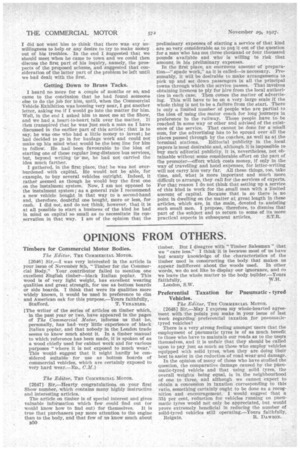OPINIONS FROM OTHERS.
Page 76

If you've noticed an error in this article please click here to report it so we can fix it.
Timbers for Commercial Motor Bodies.
The Editor, TEE COMMERCIAL MOTOR.
[2646] Sir,—I was very interested in the article in your issue of November 8th, "Timber for the Commercial Body." Your contributor failed to mention one excellent English timber—black Italian poplar. This wood is of very light weight, has excellent wearing qualities and great strength, for use as bottom boards or side boards. I think that were its qualities more widely known, it would be used in preference to elm and American oak for this purpose.—Yours faithfully, Stafford. T. VENABLES.
[The writer of the series of articles on timber which, in the past year or two, have appeared in the pages of The Commercial Motor, informs us that he, personally, has had very little experience of black Italian poplar, and that nobody in the London trade seems to know much about it. In a timber manual to which reference has been made, it is spoken of as a wood chiefly used for cabinet work and for various purposes "where it is not exposed to much wear." This would suggest that it might hardly be considered suitable for use as bottom boards of commercial vehicles, which are certainly exposed to very hard wear.—En., C.M.] The Editor, THE COMMERCIAL MOTOR.
[2647] Sir,—Hearty congratulations on your first Show number, which contains many highly instructive and interesting articles.
The article on timber is of special interest and gives valuable information which few could find out (or would know how to find out) for themselves. It is true that purchasers pay more attention to the engine than to the body, and that few of us know much about 3350 timber. But I disagree with "Timber Salesman" that we "care less." I think it is because most of us have but scanty knowledge of the characteristics of the timber used in constructing the body that makes us .appear indifferent about the woods used. In other words, we do not like to display our ignorance, and so we leave the whole matter to the body builder.—Yours faithfully, W.H. London, S.W.
Preferential Taxation for Pneumatic tyred Vehicles.
The Editor, THE COMMERCIAL MOTOR.
[2648] Sir,—May I express ray whole-hearted agreement with the points you make in your issue of last Week regarding preferential taxation for pneumatictyred vehicles?
There is a very strong feeling amongst users that the employment of pneumatic tyres is of as much benefit to those who have to maintain our roads as to the users themselves, and it is unfair that they should be called upon to pay just as much as those who employ vehicles equipped with solid tyres, when they are doing their best to assist in the reduction of road wear-and damage.
In the opinion of many of those who have studied the question, the comparative damage caused by the padamatic-tyred vehicle and that using solid tyres, the overall weights being equal, is in. the neighbourhood of one to three, and although we cannot expect to obtain a concession in taxation corresponding to this ratio, something certainly ought to be done as a recognition and encouragement. I would suggest that a 331, per cent, reduction for vehicles running on pneumatic tyres would not only -be appreciated, but would prove extremely beneficial in reducing the number of solid-tyred vehicles still operating.—Yours faithfully,
Reigate. R. DAWSON.




















































































































